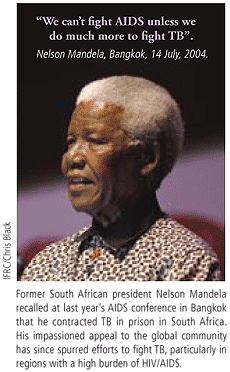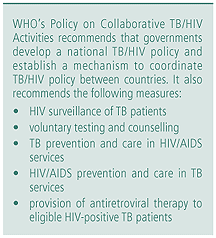NEWS
IN FOCUS
Africa is worst hit by dual epidemic
Clare Nullis-Kapp
Cape Town
The realization that it will be impossible to curb the spread of HIV/AIDS without tackling tuberculosis (TB) and vice versa has led to an upsurge in joint research, surveillance and treatment initiatives into the two diseases that are feeding off each other to devastating effect.
One-third of the estimated 40 million people living with HIV/AIDS are also infected with TB. In sub-Saharan Africa, the proportion is even higher. People infected with HIV are five to 10 times more likely to develop TB in a given year than those who are not, fuelling an upsurge in the TB epidemic which kills an estimated two million people worldwide a year.
"There were countries in Africa in the most horrendous situations of poverty and war, and yet TB rates were going down," according to Dr Bernard Fourie, honourary scientist with South Africa's Medical Research Council and former head of its TB research programme. "But since the late 1980s not one single country in sub-Saharan Africa has seen a decline."
"This is undoubtedly because of HIV," said Fourie, who worked in TB research for 30 years.
Africa is the worst hit region in terms of the impact of TB/HIV. In 2003, TB incidence fell in five of six WHO regions but increased dramatically in many African countries. South Africa is one of the hardest hit nations.

The South African Medical Research Council forecasts that there will be 300 000 cases of TB this year and 30 000 deaths from it in the country a fatality rate of 10% compared to one of 35% before the advent of HIV/AIDS. WHO said South Africa had 558 estimated cases of TB per 100 000 population in 2002, second only to Zimbabwe.
WHO's '3 by 5' Progress Report published in January estimated that between 37 000 and 62 000 people out of the 837 000 South Africans needing antiretroviral medicines (ARVs) were actually receiving the treatment at the end of December a coverage rate of 7%.
The problems faced by high burden countries such as South Africa have spurred the drive to tackle the dual epidemic with a coordinated response intended to draw on the strengths of the TB control strategy, DOTS, and the dynamism of the '3 by 5' drive to get three million people with HIV/AIDS on antiretroviral treatment by the end of 2005.
Last September WHO launched a new internal HIV/TB Task Force to boost coordination between countries and encourage TB services and HIV/AIDS programmes to work more closely together.
The Task Force was launched at the annual conference of the TB/HIV Working Group of the Global Stop TB Partnership, which was held in Addis Ababa in September last year.
The conference, grouping 40 countries and agencies, concluded that more needed to be done to implement WHO's Policy on Collaborative TB/HIV Activities. (See box on p. 166.) They agreed on the urgent need for more drugs, newer testing methods and more information on how best to treat TB/HIV dual infection and concluded that the DOTS treatment strategy for TB was essential, but not sufficient by itself.
"The top priority is strengthening of DOTS, but it is necessary to implement and scale up additional existing interventions to prevent TB, such as chemoprophylaxis, and to diagnose TB more effectively by carrying out intensified case finding" Dr Mario Raviglione, Director of WHO's Stop TB Department told the Bulletin.
"The control of HIV is key for TB control as well. Thus, any measure should be attempted to prevent HIV infection and to treat it," Raviglione said.
The meeting report called for better diagnostic tools to replace the smear microscopy test which was developed a century ago and is often too imprecise to detect TB in HIV-positive patients who show atypical symptoms.
"The long duration and high pill count of current TB drug regimens coupled with the spectre of increasing drug resistance require urgent development of new drugs," the report said.
The TB/HIV Working Group also stressed the need for further research on toxic reactions and other interactions such as reduced efficacy between ARVs and TB drugs.
There are plans for trials sponsored by the Special Programme for Research and Training in Tropical Diseases (TDR) to provide clinical evidence of efficacy, safety and concomitant use of TB and HIV drugs in co-infected patients in South Africa, the United Republic of Tanzania, Uganda and Zambia.

"African leaders must focus even more attention on TB as it is not only the major killer of HIV-infected people but a disease that is out of control on the African continent with incidence rates growing at up to 10% per year, despite all efforts made through implementation of DOTS," Raviglione said.
He said that WHO was strengthening monitoring and evaluation systems and training capacity for the two diseases. WHO is also one of the partners in CREATE, the Consortium to Respond Effectively to the AIDS/TB Epidemic, which is studying new public health strategies in resource poor settings.
As part of the US President's Emergency Plan for AIDS Relief, the US Centers for Disease Control and Prevention (CDC) has launched an initiative to help countries develop national TB/HIV surveillance systems. And there are hopes for an increase in resources for joint TB/HIV activities from the Global Fund To Fight AIDS, Tuberculosis and Malaria.
But progress on the ground remains slow. In a report issued in December, Médecins Sans Frontières (MSF) said that despite its pioneering role in treating HIV/AIDS patients in poor settings only four of its 25 HIV/AIDS programmes in sub-Saharan Africa directly provide TB treatment. The charity is running a pilot project to combine TB/HIV treatment at one of its three clinics in the impoverished Cape Town suburb of Khayelitsha, where 2000 patients are receiving ARVs. The idea is that patients receive care for both TB and HIV in one clinic visit and staff develop expertise in managing both diseases. The initial experience is promising, according to MSF spokeswoman Marta Darder.
About 60% of patients have a TB-related problem in the 90-bed medical ward at the GF Jooste Hospital, which deals with complex cases referred by day clinics in the deprived townships around Cape Town, South Africa. An estimated 50% are HIV-positive, according to Senior Specialist of ARV Services Dr Kevin Rebe.
The standard TB smear test is often negative in HIV patients, even if they have active TB, which can delay their entry into treatment under TB protocols. Results from more sophisticated techniques involving sputum culture can take up to eight weeks: a delay which can prove fatal. Given the continuing stigma of HIV, the majority of TB patients are reluctant to be tested for HIV, according to Rebe.
Treatment is even more problematic. WHO and national guidelines recommend that priority should be given to treating patients with the six-month course of TB treatment and then move on to ARVs. For patients with advanced clinical symptoms of AIDS, the alternative approach is to give a TB/HIV patient two months of TB treatment, and then to start the ARVs. But for really severely immunosuppressed patients (with a CD4 count of less than 50) the only option is to begin TB and HIV treatment simultaneously.
"We don't like to do it," said Rebe. "There is the pill burden of taking 10 or 11 tablets a day and the side-effects like nausea, vomiting, liver toxicity and peripheral neuropathy."
What Rebe finds particularly frustrating is the lack of coordination between the TB and the HIV/AIDS programmes. He said that once a patient is diagnosed with TB, they are sent to a TB clinic with little further interaction with the HIV/AIDS specialists at the hospital.
"We have to start treating these two diseases together," Rebe told the Bulletin. "TB is the most common opportunistic infection. It is the most common cause of death in a HIV-positive patient. It is the most common cause of hospitalization." 

